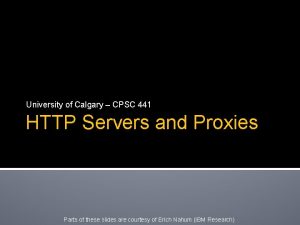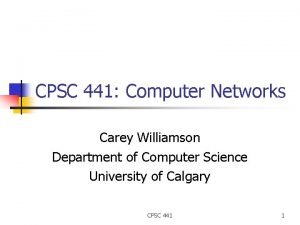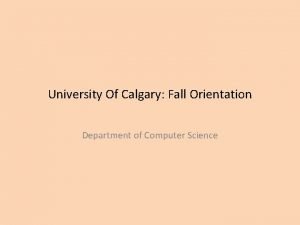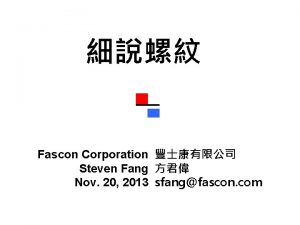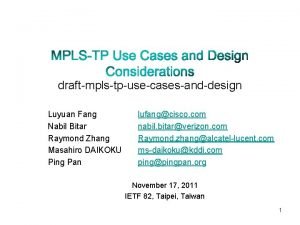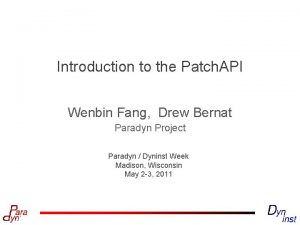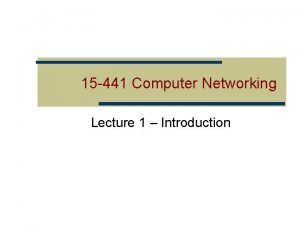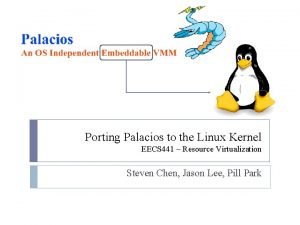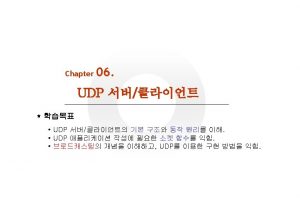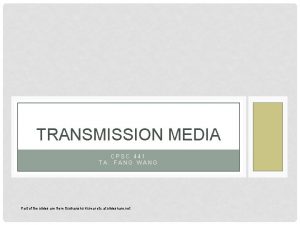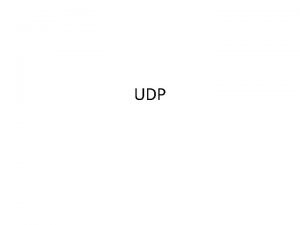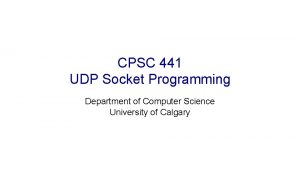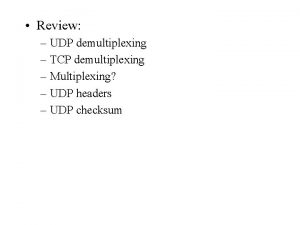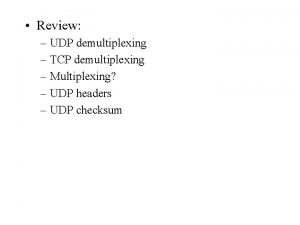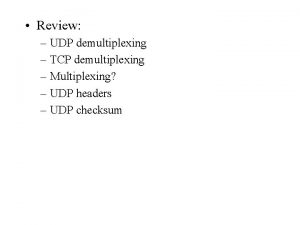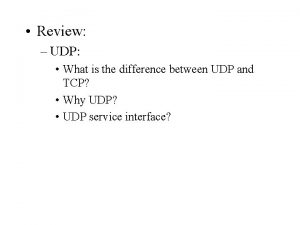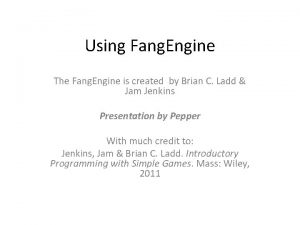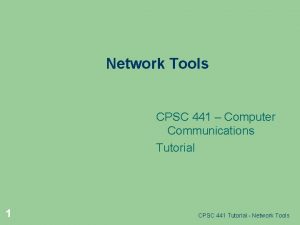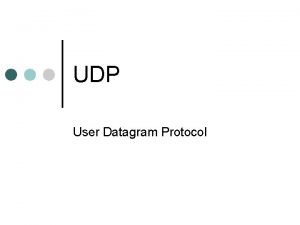Udp Review CPSC 441 Tutorial TA Fang Wang




















- Slides: 20

Udp Review CPSC 441 Tutorial TA: Fang Wang

What is UDP? � UDP stands for User Datagram Protocol. � It is a simple protocol in Transport Layer of the OSI model. UDP was defined in RFC 768. � Alternative to the Transmission Control Protocol (TCP) and, together with IP, is also referred to as UDP/IP � Programs on networked computers can send short messages sometimes known as datagram (using Datagram Sockets) to one another. 2

Features of UDP � UDP is a minimal message-oriented Transport Layer protocol. � Unreliable Datagram Protocol : � UDP provides no guarantees to the upper layer protocol for message delivery �the UDP protocol layer retains no state of UDP messages once sent � UDP provides application multiplexing (via port numbers) � Provide integrity verification (via checksum) of the header and payload. 3

UDP header � The UDP header consists of 4 fields, each of which is 2 bytes. � The use of two of those is optional in IPv 4 (pink background in table). In IPv 6 only the source port is optional. � Source port number � Identifies the sender's port , should be assumed to be the port to reply to if needed. � If not used, then it should be zero. � If the source host is the client an ephemeral port number. � If the source host is the server a well-known port number 4

UDP header � Destination port number � Identifies the receiver's port and is required � if the client is the destination host an ephemeral port number. � if the destination host is the server a well-known port number �Length � Specifies the length in bytes of the entire datagram: header and data � The minimum length is 8 bytes = the length of the header. � The field size sets a theoretical limit of 65, 535 bytes (8 byte header + 65, 527 bytes of data) for a UDP datagram 5

UDP header � Checksum � The checksum field is used for error-checking of the header and data. � If no checksum is generated by the transmitter, the field uses the value all-zeros. � This field is not optional for IPv 6. �UDP uses Pseudo header to define the checksum. It is calculated over the combination of pseudo header and UDP message. �The pseudo header contains: the IP Source Address field, the 6 IP Destination Address field, the IP Protocol field and the UDP

Basic Operations for Transmission using UDP � 1. Higher-Layer Data Transfer: An application sends a message to the UDP software. � 2. UDP Message Encapsulation: The higher-layer message is encapsulated into the Data field of a UDP message. The headers of the UDP message are filled in, including : � the Source Port of the application that sent the data to UDP � the Destination Port of the intended recipient. � The checksum value is also calculated. � 3. Transfer Message to IP: The UDP message is passed to IP for transmission. 7

Difference between TCP and UDP �One interesting video about TCP vs UDP: http: //www. youtube. com/watch? v=KSJu 5 Fqw. EMM �TCP is a connection-oriented protocol; a connection can be made from client to server, and from then on any data can be sent along that connection. �UDP is a simpler message-based connectionless protocol. The UDP messages (packets) that cross the network is in the independent units. 8

Difference between TCP and UDP 9

Why still use UDP? �TCP header is much larger than the UDP header. That header is being applied to every segments, and adds up! �UDP advantages over TCP is that its header is much smaller than TCP’s and it has much simpler processing steps. �UDP is widely used and recommended for: � When Speed Is More Important. An application values timely delivery over reliable delivery � Places where data exchanges are short and the order of reception of datagram does not matter � Acknowledgement of delivery is not needed � Applications that require multicast or broadcast transmissions, since these are not supported by TCP. 10

Some popular examples where UDP is used � Multimedia applications like streaming video , VOIP In multicast environment � If an application needs to multicast or broadcast data, it must use UDP, because TCP is only supported for unicast communication between two devices. � Domain Name System (DNS) � Simple network management protocol (SNMP) � Dynamic Host Configuration Protocol (DHCP) � Routing Information Protocol (RIP) 11

UDP Socket Programming �Interaction between the UDP server and UDP client � A UDP server does not have to listen for and accept client connections � A UDP client does not have to connect to a server. 12

UDP server socket � 1. Open a datagram socket with socket. � 2. Name the socket with the bind function, using a SOCKADDR_IN structure for the address parameter. � 3. Exchange data with a client using the sendto and recvfrom functions � 4. Close the connection with the closesocket function 13

SOCKET AND BIND FUNCTION �SOCKET FUNCTION int socket (address format, type, int protocol); int sock; sock = socket( AF_INET, SOCK_DGRAM, IPPROTO_UDP ) �BIND FUNCTION int bind( SOCKET s, const struct sockaddr FAR* name, int namelen); struct sockaddr_in myaddr; myaddr. sin_family = AF_INET; myaddr. sin_port = htons( 1234 ); myaddr. sin_addr = htonl( INADDR_ANY ); bind(mysock, &myaddr, sizeof(myaddr)); 14 If no error occurs, this function returns zero. If an error occurs, it

Sending DATA �SENDTO FUNCTION: int sendto( SOCKET s, const char FAR* buf, int len, int flags, const struct sockaddr FAR* to, int tolen ); S: Descriptor identifying a possibly connected socket. Buf: Buffer containing the data to be transmitted. Len: Length of the data in the buf parameter. Flags: Indicator specifying the way in which the call is made. To: Optional pointer to the address of the target socket. Tolen: Size of the address in the to parameter. Return value: If no error occurs, this function returns the total number of bytes sent, if an error occurs, a value of SOCKET_ERROR is returned. 15

Receiving Data �RECEFROM FUNCTION: int recvfrom( SOCKET s, char FAR* buf, int len, int flags, struct sockaddr FAR* from, int FAR* fromlen ); S: Descriptor identifying a bound socket. Buf: Buffer for the incoming data. Len: Length of the buf parameter. Flags: Indicator specifying the way in which the call is made. From: Optional pointer to a buffer that will hold the source address on return. Fromlen: Optional pointer to the size of the from buffer. Return value: If no error occurs, this function returns the number of bytes received. If the connection has been gracefully closed, the return value is zero. If an error occurs, a value of SOCKET_ERROR is returned. 16

CLOSE �More about sendto and recefrom function: � Server application calls recvfrom to prepare to receive data from a client. � The sendto function is used on a connectionless socket to send a datagram to a specific peer socket identified by the to parameter. Successfully completing a sendto function call does not confirm data was successfully delivered. �CLOSE FUNCTION int closesocket( SOCKET s ); 17

UDP client socket � 1. Open a socket with the socket function. � 2. Exchange data with server using sendto and recvfrom. � 3. Close the connection with the closesocket function. 18

Example �One simple example: ping/pong UDP client and server 19

Reference � http: //ipv 6. com/articles/general/User-Datagram-Protocol. htm � http: //www. decom. fee. unicamp. br/~cardoso/ie 344 b/User_Datagram_Protoco l. pdf � http: //www. youtube. com/watch? v=KSJu 5 Fqw. EMM � http: //en. wikipedia. org/wiki/User_Datagram_Protocol � http: //www. youtube. com/watch? v=v-Cm. Pz 73 Y 8 Q � http: //msdn. microsoft. com/en-us/library/ms 881658. aspx 20
 Cpsc 441 u of c
Cpsc 441 u of c Cpsc 441 assignment 1
Cpsc 441 assignment 1 Cpsc 441
Cpsc 441 U of c fall orientation
U of c fall orientation Cpsc 441
Cpsc 441 Fixtures and fastenings in railway ppt
Fixtures and fastenings in railway ppt Fang din by skolekonkurrence
Fang din by skolekonkurrence Steven fang
Steven fang Steven fang
Steven fang Fangland clothing
Fangland clothing W fang
W fang Criterios de fang
Criterios de fang Fang enginer
Fang enginer Luyuan fang
Luyuan fang Wenbin fang
Wenbin fang Vecurium
Vecurium Xiao ke diabetes
Xiao ke diabetes Jupiters radius
Jupiters radius Dchr paid family leave
Dchr paid family leave 15441 cmu
15441 cmu Eecs 441
Eecs 441
